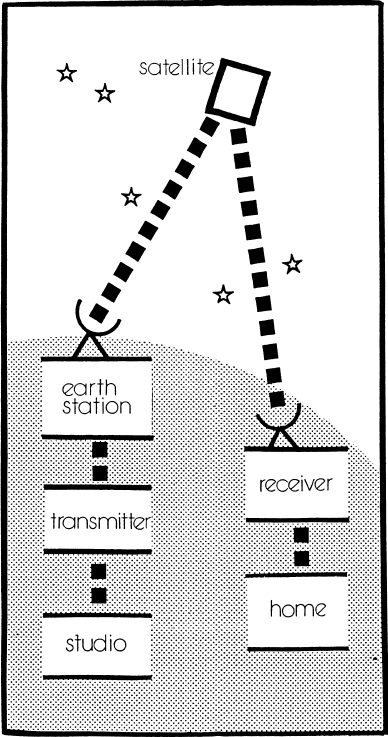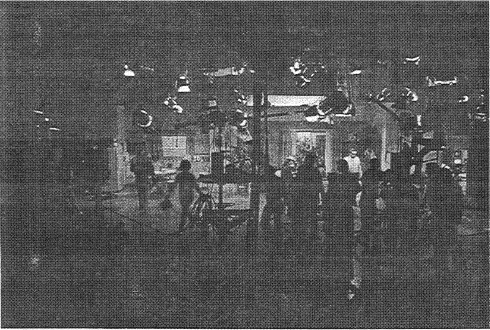The television environment presents many challenges to the production designer. Whether the recording medium is film or tape, the designer needs to know how the systems work, how to cope with the limitations, and how to exploit the medium’s advantages. However, what the designer envisions and what the viewer at home or in the theater sees may differ dramatically, even though the design team has carefully controlled the set elements placed on the stage or at a chosen location. This chapter describes what basic physical elements designers work with on the stage, how they work, and the picture limitations.
The amount of fine detail a video camera shows is more limited than the amount a film camera can show. The American video system uses 525 lines of picture information, compared to most of European video, which shows 625 lines; however, motion picture film contains millions of grains of picture information in each frame and can present a very large picture with much detail.
A clumsily attached doorknob plate is about 2 inches wide on the face of a television screen, but can be 8 feet in diameter on a 30-foot-wide motion picture screen. Designers should never allow sloppy craftsmanship to slip by because it’s just for television – they should demand the maximum quality that time and budget allow. What if the director decides to use a very tight closeup of a badly fastened doorknob plate?
Home receiver adjustment is a major video variable. We have all entered someone’s living room when the television set is on. We think: How can they watch such an unrealistic picture in exaggerated colors? Well, they must prefer hot color and low contrast. We have no control over individual taste.
As designers, we must remember that colors usually appear more saturated and brighter to the camera than to our eyes. A guiding rule is to choose paint tones that are a step down in saturation from the color you want perceived on the screen.
HOW DOES THE VIDEO PICTURE GET FROM HERE TO THERE?
The following list describes the way a picture goes through many systems that alter or transform the original source.
• The camera lens focuses light reflected from the set onto the face of a picture tube or digital sensor.
• The picture tube or chips translate the light-dark values and color variations into electronic information sent to camera control equipment.
• The mixer assembles videotape, digital disk, and live camera information into a signal that can be broadcast or recorded.
• The electronic information goes via cable or microwave transmission to a transmitter, where it is transformed into a signal broadcast to a satellite receiver, cable system microwave dish, or home receiver.
Look at some wallpaper books. When you leaf through the samples, your eyes are just a few inches away from the color and form. Walk across the room and look at the same sample again. Does the color read as a definite color, or does it turn into an indefinable tone? Does the pattern come across or does it become a mushy texture? When choosing colors, textures, and forms, select the definite statements that tell their stories at a glance. Remember how far they have to go.
Now that we have seen some of the system’s limitations, and how video pictures get from here to there, let’s get acquainted with the environment in which our sets will stand.
The production’s stage home is a barnlike building containing a lot of empty space. Stages come in many sizes, shapes, and locations, the choice of which depends on the production’s needs. If the producer works on a lot with many stages, the production is assigned an available stage. An independent producer shops around for space on lots that offer rental stages. Ideally, the producer consults the art director when reserving stage space. If this does not happen, the art director frequently has to fit the sets into a space that is too small.

Soundstages are quiet, peaceful places when empty. Thick sound-absorbent padding covers the walls and ceiling to keep out unwanted sounds. While filming or taping is in progress, warning bells ring and lights flash outside the stage doors.
Did You Pay the Light Bill?
The lighting designer needs an adequate supply of electricity, places to hang the lights, and a control system. One way to ensure good lighting is to use the traditional motion picture system – suspended platforms above the sets with lighting instruments secured to the hanging platforms. Lights on stands clutter the stage floor, but lighting people frequently use them to supplement the overhead lighting.
Another way, more commonly used for video production in which the cameras need to move freely about the floor, is to hang the lights from a permanently installed grid of pipes suspended from the stage ceiling. The lighting technicians use ladders to take the lights to the grid where they are fastened.
A convenient system is to use pipes suspended by cables from pulleys fastened to the stage ceiling. The lines pass over the pulley wheels to the stage walls, where they are attached to a counterweight system that allows the pipes to be lowered to a few feet off the floor. The lights are fastened to the pipes – a much more convenient system that eliminates ladder climbing. The light-bearing pipes can then be raised to their working height above the set.

Stages have different floor surfaces. Some have rough wood which the art director has to cover with plywood or composition material. Stages used primarily for video work have polished vinyl floors that blend smoothly into the cyclorama, a vertical surface made of plaster, wood, or cloth. To create a horizonless effect, the cyclorama – or eye for short – commonly matches the color of the floor.
Lighting technicians can bathe the floor and eye with colored light and projections, and scenic artists can paint the floor and eye with color and patterns. Many large studios have stages devoted to outdoor scenes, complete with dirt, trees, rocks, and shrubbery.
Video cameras convert light energy into electrical energy and film cameras cause chemical changes in film emulsions, but cameras don’t see the same angles our eyes do. Our eyes take in a wide angle of vision. Cameras see a much more limited field, even in wide-screen formats.
Aspect ratio is the proportion of the picture – the relationship of height to width. The television picture aspect ratio is 1.33:1, that is, one and thirty-three hundredths units wide to one unit high. Theatrical motion picture film formats take in a wider, more horizontal field of vision, commonly a ratio of 2.35:1. Art directors need to adjust designs to the field taken in by the camera.
Remember Close-ups and Wide Shots
To get a sense of how much of the world a camera eye sees, cut a 3" x 4" horizontal hole in a piece of cardboard. Hold it in front of one eye and observe your surroundings. Notice how your attention is drawn to one small area at a time and how the pictures become a series of compositions. You are not, of course, aware of the whole room or landscape, just a small portion. No matter how lavish your set may be when seen as a whole, don’t forget the small areas in your $1 million set, or you may get $1.98 close-ups.
Most camera lenses make what they see appear larger than it does to the eye. Usually, designers make a set more compact for the camera than they would for a home interior to be lived in. If the room were designed to be made life-size, it might look like a civic auditorium to the camera.
The Eye with Blinders
Cameras play tricks on us sometimes as they look at small areas of a set. Watch for the crooked picture, the potted plant that seems to grow out of an actor’s head, or the high-backed chair that makes an actor appear to have sprouted wings. While you as art director stand around the set waiting for the coffee break, look at the camera monitor when the director lines up close-ups; this is the perfect time to move that plant.
•
Now that you know where your work is going to be housed and what the camera may see, we’ll look at the basic elements of set construction.
